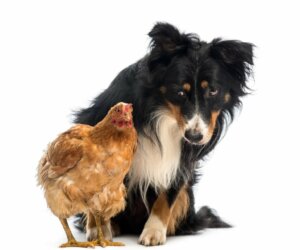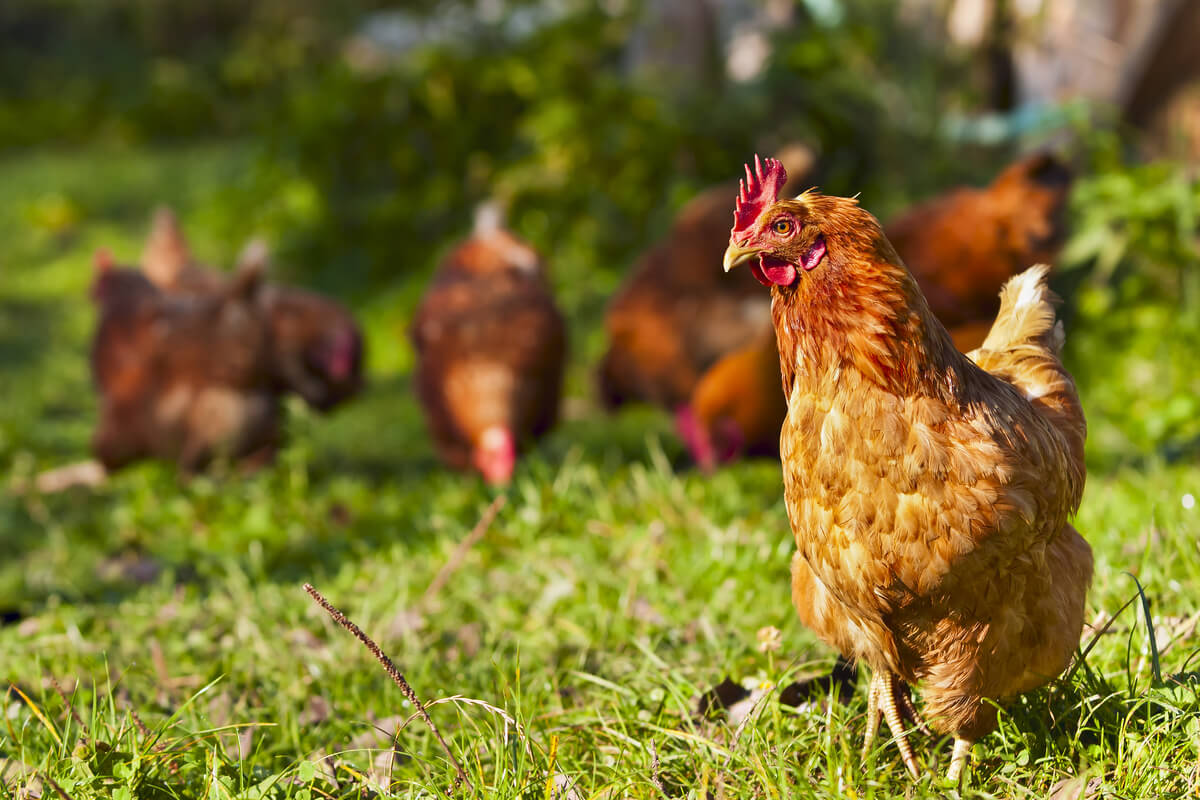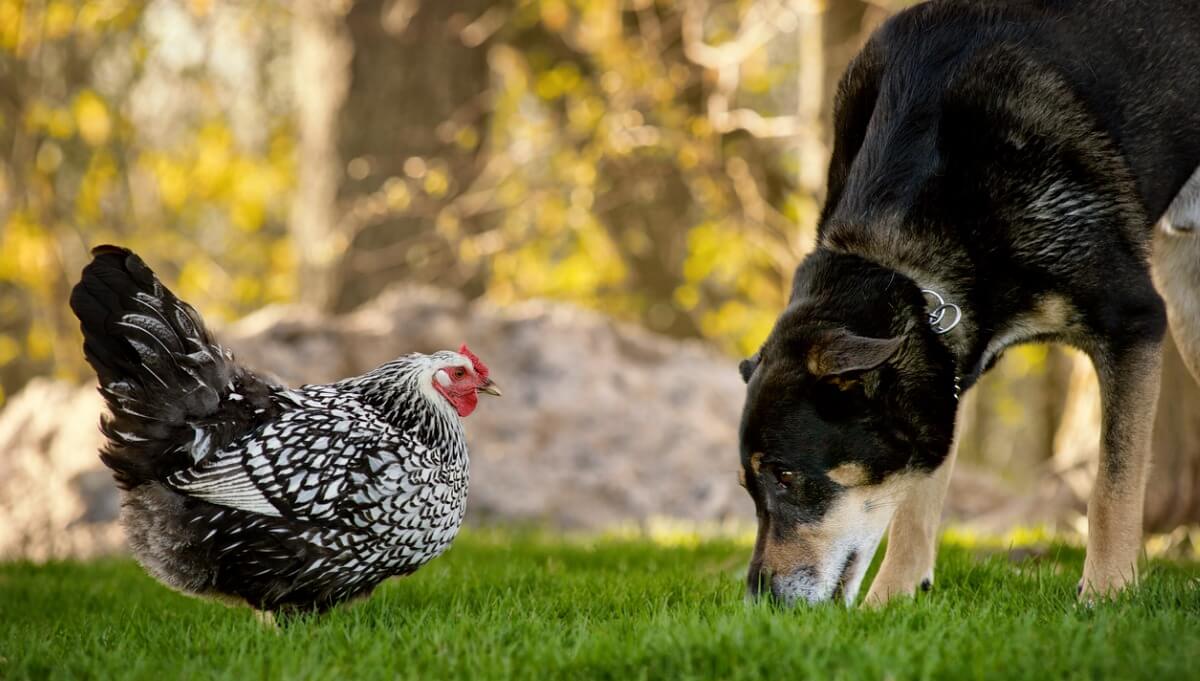Why Does My Dog Attack Chickens and How to Prevent It?

Why does my dog attack chickens?! In certain environments, such as rural areas, several species of animals often live together in the same space. When there are dogs and chickens living together – as they are predators and prey – you may wonder how to avoid problems between them.
Avoiding this conflict is vital, as the wounds suffered by these birds are usually serious and even fatal if a dog attacks them. In addition, you can suffer legal consequences if the chickens belong to someone else.
Why does my dog attack chickens?
The underlying cause of why a dog attacks chickens is usually its hunting instinct. Even if it isn’t hungry, the dog can see these birds as a target of its predatory instinct.
On the other hand, a very territorial dog will tend to defend an area that it considers to be its own. If chickens – or other animals – are within that territory, it will attack them or try to scare them. Although it may not harm them physically, birds are very delicate when it comes to stress, as they can even die of a heart attack.

How to avoid dog attacks on chickens
In places where many different species live and individuals constantly enter, it’s inevitable that prey and predators will have to coexist. In addition, introducing new animals often leads to conflicts in species that are organized hierarchically.
When a canine begins to live in a place where chickens live, and it starts to attack them, then there needs to be a two-fold plan. You must get it used to the presence of these birds and teach it not to disturb them. Below, you can read some tips to achieve coexistence between both species.
Walking the dog
If the dog has a long walk or uses a good amount of energy, it will be more relaxed and react more calmly when encountering other animals. Especially in the case of nervous dogs, not accumulating excess energy is key to avoid aggressiveness against chickens.
Put the hens in the henhouse before starting the training
Chickens recognize the dog as a predator, and so it’s more than likely that they’ll run and fly as soon as they appear. If this happens, the dog will be prone to chasing them. Avoiding this is as simple as putting the birds in their henhouse before the dog goes out into the yard.
Once the dog – who has already used a lot of their energy with the walk – is near the chicken facility, you should ask them to sit down and remain calm. Then, calmly, release the chickens. If the dog reacts, ask it to remain calm. If it does, then reward it.
If your dog attacks chickens, let them meet through the fence
It’s better to carry out the encounters to get the dog used to the presence of the chickens with a fence in between. In this way, the birds can take refuge if they feel in danger and the dog will be able to smell them and get used to them, without having the opportunity to harm them.
Once the dog isn’t reacting to the birds from outside its installation, you can enter the henhouse with it and continue with the process there. If you don’t feel sure it will behave, then using a leash is an option.
Be consistent
Training doesn’t work overnight, but don’t despair: if orders to keep calm and reinforcements are consistent, then dog will eventually learn not to attack the chickens. They will also have time to get used to the dog at their own pace.
What not to do if the dog attacks the chickens
In conclusion, it never hurts to remember that punishment isn’t an appropriate method of behavior modification. Inducing fear in the dog through yelling or aggression of any kind will only lead to the dog disobeying as soon as you turn around – in the best of cases.
On the other hand, chickens need to be as stress-free as possible. Nor is it a valid method to try to make them learn to flee when a predator appears daily, as they can develop many health problems derived from it.

If you’re patient and consistent with training, all the species of animals that live with you can live in harmony. The ability of animals to seek to live in peace will surprise you, as long as they don’t lack sufficient resources for their well-being.
Why does my dog attack chickens?! In certain environments, such as rural areas, several species of animals often live together in the same space. When there are dogs and chickens living together – as they are predators and prey – you may wonder how to avoid problems between them.
Avoiding this conflict is vital, as the wounds suffered by these birds are usually serious and even fatal if a dog attacks them. In addition, you can suffer legal consequences if the chickens belong to someone else.
Why does my dog attack chickens?
The underlying cause of why a dog attacks chickens is usually its hunting instinct. Even if it isn’t hungry, the dog can see these birds as a target of its predatory instinct.
On the other hand, a very territorial dog will tend to defend an area that it considers to be its own. If chickens – or other animals – are within that territory, it will attack them or try to scare them. Although it may not harm them physically, birds are very delicate when it comes to stress, as they can even die of a heart attack.

How to avoid dog attacks on chickens
In places where many different species live and individuals constantly enter, it’s inevitable that prey and predators will have to coexist. In addition, introducing new animals often leads to conflicts in species that are organized hierarchically.
When a canine begins to live in a place where chickens live, and it starts to attack them, then there needs to be a two-fold plan. You must get it used to the presence of these birds and teach it not to disturb them. Below, you can read some tips to achieve coexistence between both species.
Walking the dog
If the dog has a long walk or uses a good amount of energy, it will be more relaxed and react more calmly when encountering other animals. Especially in the case of nervous dogs, not accumulating excess energy is key to avoid aggressiveness against chickens.
Put the hens in the henhouse before starting the training
Chickens recognize the dog as a predator, and so it’s more than likely that they’ll run and fly as soon as they appear. If this happens, the dog will be prone to chasing them. Avoiding this is as simple as putting the birds in their henhouse before the dog goes out into the yard.
Once the dog – who has already used a lot of their energy with the walk – is near the chicken facility, you should ask them to sit down and remain calm. Then, calmly, release the chickens. If the dog reacts, ask it to remain calm. If it does, then reward it.
If your dog attacks chickens, let them meet through the fence
It’s better to carry out the encounters to get the dog used to the presence of the chickens with a fence in between. In this way, the birds can take refuge if they feel in danger and the dog will be able to smell them and get used to them, without having the opportunity to harm them.
Once the dog isn’t reacting to the birds from outside its installation, you can enter the henhouse with it and continue with the process there. If you don’t feel sure it will behave, then using a leash is an option.
Be consistent
Training doesn’t work overnight, but don’t despair: if orders to keep calm and reinforcements are consistent, then dog will eventually learn not to attack the chickens. They will also have time to get used to the dog at their own pace.
What not to do if the dog attacks the chickens
In conclusion, it never hurts to remember that punishment isn’t an appropriate method of behavior modification. Inducing fear in the dog through yelling or aggression of any kind will only lead to the dog disobeying as soon as you turn around – in the best of cases.
On the other hand, chickens need to be as stress-free as possible. Nor is it a valid method to try to make them learn to flee when a predator appears daily, as they can develop many health problems derived from it.

If you’re patient and consistent with training, all the species of animals that live with you can live in harmony. The ability of animals to seek to live in peace will surprise you, as long as they don’t lack sufficient resources for their well-being.
All cited sources were thoroughly reviewed by our team to ensure their quality, reliability, currency, and validity. The bibliography of this article was considered reliable and of academic or scientific accuracy.
- Schöning, B. (2011). Guía práctica del comportamiento del perro. Editorial HISPANO EUROPEA.
- The Open Sanctuary Project, Inc. (2020, 23 diciembre). How Chickens Get Along With Other Species. The Open Sanctuary Project. https://opensanctuary.org/article/chickens-and-other-species/
- González Alonso, A. (2017). Clases de cachorros y problemas de comportamiento en perros.
This text is provided for informational purposes only and does not replace consultation with a professional. If in doubt, consult your specialist.








